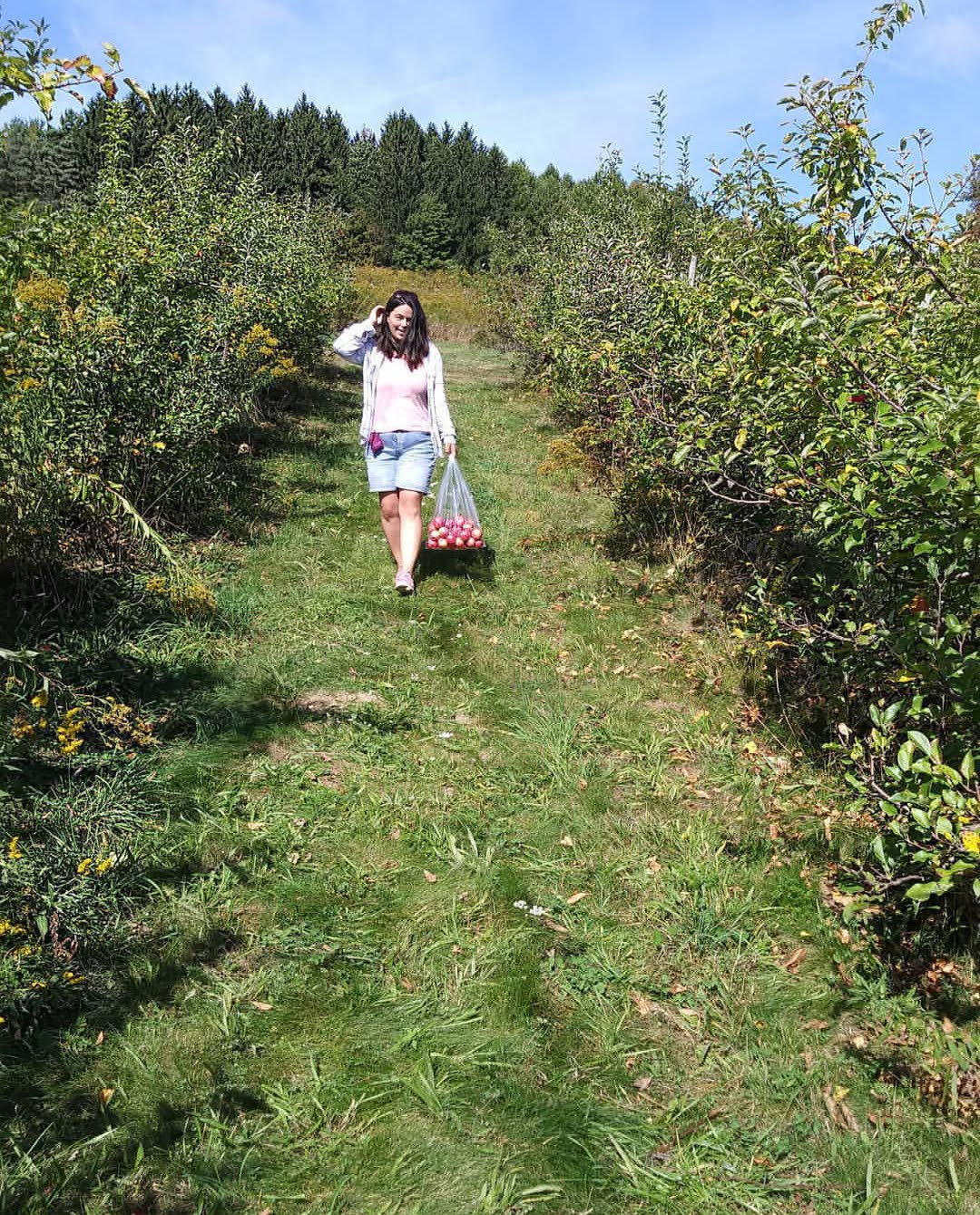
Come along on my journey through my first apple season, from the orchard to the table.

Learning Appreciation
This might come as a shock but I’ve never been a huge fan of fruit. I usually put it in a smoothie, or reluctantly eat a piece of fruit, or hide it in some baked goods. I’ve never really had a full appreciation of fruit. That is until My First Apple Season here in Upstate New York.
Where I grew up in southern Oregon there was always an abundance of fruit growing around. Apples, Peaches, Plums, Pears, Berries and even Figs. But I never had but a passing interest in them. How can I hide them or mask them to get the nutrients out of them without tasting them? That was my mindset.
Fast forward to my move to Upstate NY where winters feel like they last for 9 months out of the year. I suddenly missed those long hot dry summers I use to hate so much. Not for the reasons, most people think though, I have an abnormally high body temperature than the average person. So I overheat easily, I loved the long season for gardening and enjoying time outdoors just not the heat.

Embracing Change
The beauty of this area could be lost on those who hate the cold, snow and ice. But for this girl from sunny southern Oregon where we average one inch of snow on the valley floor per year and it’s gone by noon I love this cold climate. I love it for the fact that I am much more comfortable for more months out of the year. I don’t overheat as often. And I’ve gained an appreciation for summer and growing season that I didn’t have before.
Growing here is a challenge and yet most of us can trace our family back to this area. My great grandmother came through Ellis Island. My distant relative Reverend John Lothropp and the first immigrant to the new world landed in Massachusetts. At some point, I will get into Geneology again so stay tuned for that.
What I love most about this area is how green it is almost year-round. Which you can contribute to the amount of precipitation they get here. And boy will you hear everyone complain about that. It makes me giggle because if they were from where I was from they would complain about the heat and lack of rain. We all seem to want what we don’t have.

Picking The Right Farm
This was my first apple season and my first time going picking. We went on a sunny and brisk fall day in September. The orchard we went to is Lone Maple Farm. A small locally owned and operated family farm.
Although they are not certified, they use Organic growing practices for all their crops. They use non-GMO seeds, organic seeds, organic growing media, and organic fertilizers whenever possible. That allows them to keep the costs down but quality and food safety high.
The above information can be found on their website under their Growing Philosophy tab. Which for us helped us decided to go here in the first place. We loved their emphasis on the highest quality, highest nutritional value, and the safest fruits and vegetables for their customers.

New Experiences
Together we took a small tractor ride to the orchard and were told what was available to pick and what they were best used for. We separated ours by bag color and I put that information in my phone. We did try each apple right off the tree and let me tell you, eating an apple in the sunny orchard on a cool fall day is an experience in and of its self that everyone should experience at least once in their lifetime. Especially if this is your first apple season as well.

Learn Your Apples
First, we picked the Macoun: ‘Macoun’ apples are a cross between the ‘McIntosh’ and ‘Jersey Black’ cultivars. The Macoun was developed at the New York State Agricultural Experiment Station in Geneva, by Richard Wellington. It was first introduced in 1923 and is an eating apple.

The second one we picked was Gala: The first Gala apple tree was one of many seedlings resulting from a cross between the Golden Delicious and a Kidd’s Orange Red planted in New Zealand in the 1930s by orchardist J.H. Kidd. Gala apples are non-uniform in color, usually vertically striped or mottled, with overall orange color. They are sweet, fine-textured, and aromatic, can be added to salads, cooked, or eaten raw, and are especially suitable for creating sauces.

Lastly, we picked Cortland apples: Cortland is a cultivar of apple, that was raised in the New York State Agricultural Experiment Station in Geneva, New York, the United States in 1898. The apple was named after nearby Cortland County, New York. After the many attributes of McIntosh were discovered, plant breeders began crossing it with other varieties to enhance its traits. One of the earliest was the ‘Cortland’. Its flavor is sweet compared to McIntosh, and it has a flush of crimson against a pale yellow background sprinkled with short, dark red stripes and gray-green dots. It was first bred by American horticulturalists S.A. Beach. It has very white flesh and makes a great dessert apple.

Taking It All In
It really was such a beautiful day. Walking through the orchard on a sunny cool fall day. The scenery of the surrounding mountains. The breeze as it rustled through the autumn leaves. Everything felt scenery, picturesque and like pure poetry.

We took a short tractor ride back, picked up a few items from the country store. Lemons and Apple Cider were among the few. We paid 46c per lb for the apples and we picked over 40 lbs of apples. It was well worth the trip and a small amount of labor, which didn’t feel like labor at all, to get this many apples for that price.

Game Plan
Once home we had to make plans on what to do with all these apples. I decided on Apple Pie Filling, Apple Sauce and Applebutter. After checking all my equipment, jars, lids and seals I made a list of everything I would need for the recipes.
I ended up reordering a canner and canning kit from Walmart as the one I had was left by the previous owners and was very rusted and the enamel chipped. I didn’t want to take a chance on this thing leaking. It will find a new life as a planter outside.
I won’t be including recipes in this post as it’s more about my experience and new found love of apple season. This adventure makes me want to do it every year and now we will have a new tradition as a family. I do wish we could have brought Berkeley our Bernese Mountain Dog along. I know she would have loved it.

Apple Pie Filling
The order in which I canned was Apple Pie Filling first as that was the most involved and time-consuming of them all. I figured out quickly that I would definitely be needing an apple peeler next year. As this was the most tedious task of them all. I now understood why my mother and grandmother had arthritis.
I do enjoy making the wedges myself. Once the apples are peeled slicing them up was easy. I didn’t like the uniform factory look of the apples when they went through the slicer. This part was purely a labor of love. I didn’t have to do it but I did because I wanted these to be beautiful not only in the jar but also when you ate them.
I quite enjoyed the look of the apples all prettily sliced, with their slight pink flesh, in my large red bowl. The filling tasted heavenly and I used the Cortlands for this as recommended by the apple farmer and Wikipedia. It took me two days to do this and I got a dozen quarts of apple pie filling from all my Cortland apples.

Apple Sauce
On day three of my canning, I decided to use the Gala apples to make my apple sauce. This process could have been made quicker and less messy had I had an immersion blender on hand. Add that to my list for next year. For this, the prep time was much shorter. I only had to peel, core and quartered the apples.
Then you pack your instant pot to the top add in your ingredients, depending on the recipe, add a cup of water and the instant pot does the rest. If I had an immersion blender this would have just been blended in the pot and then canned from there. But no, I like to do things the difficult way and had to ladle from the pot into a blender. Dump from the blender into a bowl, until everything was blended and then dump it back into the pot. Easy right?
So after that, I canned as usual and did pint jars this time. Got 6 pints of apple sauce. I will have to make more next year as this one is going to go very fast. I don’t think they will last long in the pantry at all.

Apple Butter
Day four of canning I did the easiest of them all, the apple butter. The only apples left were the Macoun. Pack the quartered, cored and rinsed apples into your instant pot with a little water. Seal up the instant pot and in no time it will be done.
Again an immersion blender would have been handy and made quick work of this. I do think in this instance a slow cooker would’ve been a better tool to use for cooking this down. I might have to repurchase a slow cooker in the future. But for now, putting it on a slow heat and stirring constantly is what I have to do. Out of this batch, I also got 6 pints of apple butter.
We gave the leftover apples, from this first apple season to the forest animals. Had I processed them I would have had another 6 pints of apple sauce or apple butter. So technically out of 40 lbs of apples, we would have had 5 days of processing and 12 quarts of apple pie filling and 18 pints of applesauce/apple butter depending on what you chose to do.

Apple Baked Goods
I’ve made several things now since I finished all this canning this first apple season. Apple Pie, Apple Turnovers, Apple Cake, English Muffins with Apple Butter, and Apple Pie Bars. By far the big favorite was eating the Apple Sauce straight out of the jar. I will be making a lot more Apple Sauce next year. All in all, this was a fun, challenging and nostalgic adventure that I hope will become a family tradition from now on.



